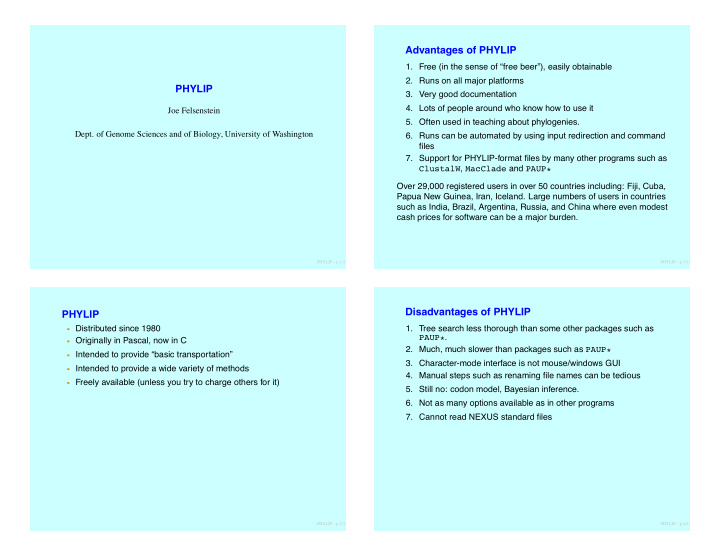



Advantages of PHYLIP 1. Free (in the sense of “free beer”), easily obtainable 2. Runs on all major platforms PHYLIP 3. Very good documentation 4. Lots of people around who know how to use it Joe Felsenstein 5. Often used in teaching about phylogenies. Dept. of Genome Sciences and of Biology, University of Washington 6. Runs can be automated by using input redirection and command files 7. Support for PHYLIP-format files by many other programs such as ClustalW , MacClade and PAUP* Over 29,000 registered users in over 50 countries including: Fiji, Cuba, Papua New Guinea, Iran, Iceland. Large numbers of users in countries such as India, Brazil, Argentina, Russia, and China where even modest cash prices for software can be a major burden. PHYLIP – p.1/11 PHYLIP – p.3/11 Disadvantages of PHYLIP PHYLIP Distributed since 1980 1. Tree search less thorough than some other packages such as PAUP* . Originally in Pascal, now in C 2. Much, much slower than packages such as PAUP* Intended to provide “basic transportation” 3. Character-mode interface is not mouse/windows GUI Intended to provide a wide variety of methods 4. Manual steps such as renaming file names can be tedious Freely available (unless you try to charge others for it) 5. Still no: codon model, Bayesian inference. 6. Not as many options available as in other programs 7. Cannot read NEXUS standard files PHYLIP – p.2/11 PHYLIP – p.4/11
PHYLIP programs Format for trees in tree files (Newick standard) (Mouse:0.87231,Bovine:0.49807,(Gibbon:0.25930,(Orang:0.24166, infile (Gorilla:0.12322,(Chimp:0.13846, outfile intree Human:0.08571):0.06026):0.04405):0.10815):0.39538); PHYLIP weights programs outtree More than such tree can be placed end-to-end in the same tree file. categories plotfile The Newick standard was defined by an informal standards committee in fontfile 1986. It is described on this web page: These are the default file names. If the input files do not exist (or if the http://evolution.gs.washington.edu/phylip/newicktree.html output files exist and you choose not to overwrite them), you will be asked for the file name. This is not a bug. PHYLIP – p.5/11 PHYLIP – p.7/11 Input format for PHYLIP (DNA, Interleaved) PHYLIP guide 7 112 Bovine CCAAACCTGT CCCCACCATC TAACACCAAC CCACATATAC AAGCTAAACC AAAAATACCA A useful guide to using PHYLIP with molecular sequences has been Mouse CCAAAAAAAC ATCCAAACAC CAACCCCAGC CCTTACGCAA TAGCCATACA AAGAATATTA produced by Jarno Tuimala. It can be downloaded as a PDF from Gibbon CTATACCCAC CCAACTCGAC CTACACCAAT CCCCACATAG CACACAGACC AACAACCTCC Orang CCCCACCCGT CTACACCAGC CAACACCAAC CCCCACCTAC TATACCAACC AATAACCTCT Gorilla CCCCATTTAT CCATAAAAAC CAACACCAAC CCCCATCTAA CACACAAACT AATGACCCCC http://koti.mbnet.fi/tuimala/oppaat/phylip2.pdf Chimp CCCCATCCAC CCATACAAAC CAACATTACC CTCCATCCAA TATACAAACT AACAACCTCC Human CCCCACTCAC CCATACAAAC CAACACCACT CTCCACCTAA TATACAAATT AATAACCTCC or using the link to it on the main PHYLIP web page. CCCCAGCCCA ACACCCTTCC ACAAATCCTT AATATACGCA CCATAAATAA CA TCCCACCAAA TCACCCTCCA TCAAATCCAC AAATTACACA ACCATTAACC CA GCACGCCAAG CTCTCTACCA TCAAACGCAC AACTTACACA TACAGAACCA CA ACACCCTAAG CCACCTTCCT CAAAATCCAA AACCCACACA ACCGAAACAA CA ACACCTCAAT CCACCTCCCC CCAAATACAC AATTCACACA AACAATACCA CA ACATCTTGAC TCGCCTCTCT CCAAACACAC AATTCACGCA AACAACGCCA CA ACACCTTAAC TCACCTTCTC CCAAACGCAC AATTCGCACA CACAACGCCA CA PHYLIP – p.6/11 PHYLIP – p.8/11
For more information on many other programs What to do in the PHYLIP likelihood lab exercise 1. Get a DNA or protein sequence data set of aligned sequences. You can use one of the ones provided by the course if you wish. They ... at my PHYLIP web site there is a master list of over 350 phylogeny are also at programs, with descriptions and links. http://evolution.gs.washington.edu/sisg/2010/data.html To find it simply put the phrase “Phylogeny Programs” into your favorite 2. Copy the data file to file infile , and then run either Dnaml or search engine. Proml , whichever is appropriate. Use the R and then A options to do a “Gamma distributed rates” analysis with a mean blobk length of about 3. After you accept the menu settings, you will be asked for a coefficient of variation of rates (you could set this at 2.0) and for the number of rate categories used to approximate the gamma distribution (about 5-6 would be good) . 3. Look at the tree by looking at the output file outfile (when you examine that file, you will need to make sure the font is a fixed-width one such as Courier) and also by renaming outtree to intree and then using Drawgram (perhaps with font file font1 ). You can also try Drawtree . (In using these, when you get a preview of the graph, use the menu to choose File whether you want to change settings. The final plot will be called plotfile . PHYLIP – p.9/11 PHYLIP – p.11/11 What to do in the PHYLIP bootstrap lab exercise 1. Use a likelihood method to do a bootstrap analysis: (use Seqboot , then renaming outfile to infile , (Don’t do for a big data set as this will be too slow for the exercise). 2. Use that infile as an input for Dnaml or Proml , using the M (Multiple input data sets) option. When asked for how many Jumbles choose 1, when asked for a random number seed give any odd number. 3. Rename the output file outtree (which will contain perhaps 100 bootstrap estimates of the tree) to intree . 4. Run program Consense which makes an Extended Majority-Rule Consensus Tree from these 100 (or so) trees. 5. Look at the consensus tree by examining outfile or by renaming outtree to intree and running either Drawgram or Drawtree . 6. The branch lengths of this consensus tree are weird (they reflect levels of bootstrap support rather than amounts of change. Can you figure out a way, using the original sequences and the consensus tree and menu option U (User-defined tree) in the likelihood program, to get more reasonable branch lengths in that tree? PHYLIP – p.10/11
Recommend
More recommend